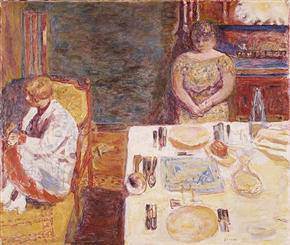
Pierre Bonnard – Before Dinner, 1924 – Metropolitan Museum of Art, New York
![Pierre Bonnard - Dining Room Overlooking the Garden [The Breakfast Room] (1930–31)](https://theartwolf.com/wp-content/uploads/2021/05/bonnard-dining-room.jpg)
Pierre Bonnard – Dining Room Overlooking the Garden [The Breakfast Room] (1930–31)
Pierre Bonnard’s luminous late interiors featured in Metropolitan Museum exhibition
Pierre Bonnard: The Late Interiors will feature 80 paintings, drawings, and watercolors that date from 1923 to 1947, when Bonnard centered his painting activity in Le Cannet, a hill town in the south of France
January 27–April 19, 2009
]]>
More modern than is commonly recognized, the late work of Pierre Bonnard is remarkable for the artist’s individualistic approach to color, light, perspective, and composition—particularly as seen in his interiors and still lifes. Although less well-known than his paintings of bathers, Bonnard’s late interiors and still-life paintings are equally extraordinary. Over the course of 24 years of painting the simply furnished, familiar rooms of his house at Le Cannet, Bonnard discovered infinite possibilities, much as Paul Cézanne had discovered in the landscape of Mont Sainte-Victoire. The exhibition will feature the artist’s finest interiors, including Corner of the Dining Room at Le Cannet, The White Interior, and The French Window, all from 1932.
Bonnard’s late interiors and still lifes explore a multitude of nuanced color relationships among glowing yellows, violets, reds, oranges, greens, and whites, as in Basket of Fruit: Oranges and Persimmons (ca. 1940) and Bouquet of Mimosas (ca. 1945). His images of fruits and bread baskets, teapots and milk jugs, in such paintings as Breakfast (ca. 1930) and The Dessert (1940), transcend domestic narratives to speak of the artist’s process of creating pictures through a masterful orchestration of color and light.
Although Bonnard’s subjects were close at hand, he rarely painted directly from life, relying instead on pencil drawings sketched rapidly in little diaries. Four of the artist’s diaries from his years at Le Cannet will be loaned by the Bibliothèque national de France, Paris. The diary notations lay out idiosyncratic marks as reminders of color, tone, intensity, and contrast. These shorthand sketches were critical to the genesis of large-scale paintings, which Bonnard developed slowly, through a process of continual editing and revision. He often worked on several paintings at once, tacking the unstretched canvases to his studio wall in order to allow for alteration of the periphery of the painting and its overall proportions.
In creating his paintings, the artist deferred to the memory of perception. His interest lay in exploring how diverse objects interrelate within a pictorial field, rather than dwelling on the literalness of any object or figure. For instance, in the paintings Still Life with Ham (1940) and Young Women in the Garden (Renée Monchaty and Marthe Bonnard) (ca. 1921–23, reworked 1945–46), equal attention is paid to every component of a painting. Negative spaces are as important as positive forms, thus achieving a kind of “overallness” in the composition.
Bonnard created a body of work that became less obviously descriptive and more metaphoric over time. The artist played with conventions of perspective and proportion and intensified the relationships among objects and figures to a disquieting effect. Bonnard’s paintings often convey a feeling of forbidden sights, as if one is trespassing among private or intimate settings. In Before Dinner (1924), the figures, though physically present, are emotionally absent. In later paintings figures become peripheral, even lacking corporeality. Some figures begin to disappear off the picture plane, as in Dining Room Overlooking the Garden [The Breakfast Room] (1930–31) and Table in Front of the Window (1934–35). Through a shimmering palette of intense, pulsating colors and a fluid interaction between foreground and background, the forms and spaces of Bonnard’s still lifes and interiors are not still at all, but quietly transient.
Follow us on:

